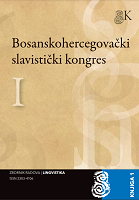Pravopisna norma i standardizacija hrvatskoga jezika devedesetih godina 20. stoljeća i početkom 21. stoljeća
Orthographic standard and standardization of the Croatian language in late 20th century and early 21st century
Author(s): Ante BičanićSubject(s): Morphology, Historical Linguistics, South Slavic Languages, Phraseology
Published by: Slavistički komitet BiH
Keywords: orthographic standard; standardization of the Croatian language; Croatian orthographic; orthographic handbooks; orthographic norm;
Summary/Abstract: In the 1990s standard Croatian was a highly standardized language, as were most other European standard languages However, there were also nonstandardized linguistic elements, especially in the fields of svocabulary and orthography. Croatia’s independence ensured a more favourable political and social climate for the standardization of Croatian through the provision of Article 12 of the Constitution of the Republic of Croatia. Before 1990s the orthographic standard was codified in Pravopisni priručnik hrvatskoga ili srpskoga jezika (The Handbook of Croatian or Serbian Orthography) by V. Anić and J. Silić (1986). In 1990 a new edition of the 1971 Hrvatski pravopis (The Croatian Orthography) by S. Babić, B. Finka and M. Moguš was published, which was later reprinted several times. This means that in the 1990s two orthographic standards were in public use and written practice in Croatia, whose general concepts as well as individual orthographic rules were different. Further confusion in the orthographic standard was brought about by Hrvatski školski pravopis (The Croatian School Orthography) authored by S. Babić, S. Ham and M. Moguš in 2005 and by Hrvatski pravopis (The Croatian Orthography) authored by L. Badurina, I. Marković and K. Mićanović in 2007. The Croatian orthographic standard is today codified in four different orthographic handbooks, different both in their general concepts and individual orthographic rules. However, these rules are in most cases either the same or very similar and they follow the centuries-old Croatian orthographic tradition. Furthermore, none of the above mentioned dictionaries has been officially approved by the Ministry of Science, Education and Sports for public use. The current orthographic situation in Croatia is not good because some orthographic issues raised by the contemporary society and science still remain open.
Journal: Bosanskohercegovački slavistički kongres
- Issue Year: I/2012
- Issue No: 1
- Page Range: 13-23
- Page Count: 11
- Language: Croatian

